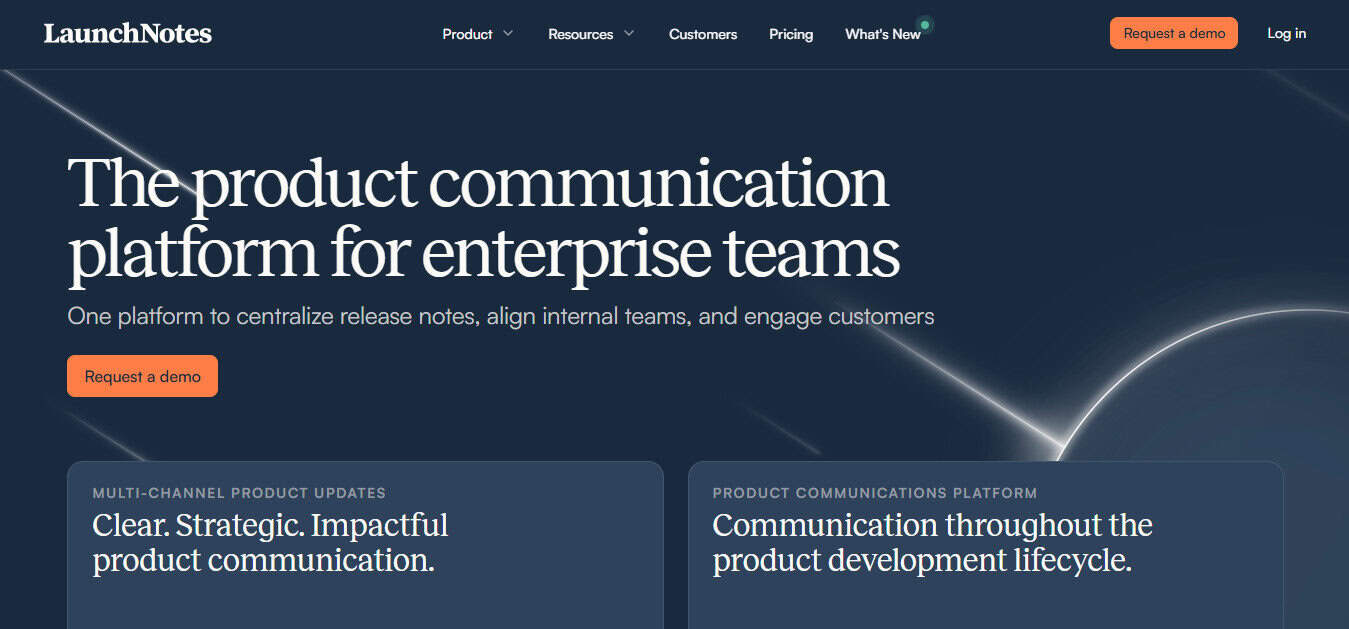- Key differences:
- 1. Basic Terms and Characteristics of Changelogs and Release Notes
- What is a Changelog?
- What are Release Notes?
- 2. When to Use a Changelog or Release Notes
- 3. Best Practices for Creating a Changelog
- 4. Best Practices for Creating Release Notes
- Should I Use Software Tools to Write Changelogs and Release Notes?
- Which is Best for Me?
Last Updated on October 3, 2025 by Ewen Finser
While both changelogs and release notes tend to get used interchangeably, they differ in multiple ways and have specific use cases. If your organization needs to communicate product changes internally and externally, it’s essential to understand the best way to keep users informed and up to date in a way that is user-friendly and accessible.
There are also best practices to keep in mind when creating both changelogs and release notes.
Changelogs and release notes are critical for clear communications regarding product updates; however, you’ll want to consider the audience and purpose of your updates.
I prefer to use tools and purpose-built software to help manage changelogs and release notes. Providing regular updates about your product helps maintain a solid level of consistency, but can also save considerable time when creating urgent communications.
I’ll showcase how to use a product communication platform to help you in each scenario.
At a high level, these are key differences to keep in mind before we run through the detailed comparisons and use cases for each.
Key differences:
ChangeLog: Main Features | Release Notes: Main Features | |
Audience & use-case | Generally targeted at internal or administrative/power users, such as technical teams or developers. Use case: Tracking developmental changes to a bug fix | Generally targeted at users, external users, customers, and stakeholders. Use case: Customer engagement or product teams communicating key updates or announcing new features. |
Content & level of detail | Comprehensive and structured list of all changes. High level of detail. This is generally formatted in chronological order, detailing what was changed and when it was changed. | Less comprehensive and more high-level detail around relevant changes and how this impacts the user(s). |
Format and style | Simple formatting. Typically handled in HTML or Markdown format. | Customer-friendly and visually appealing, containing branding, images, and a professional-looking format. |
1. Basic Terms and Characteristics of Changelogs and Release Notes
Let’s drill down into the details about what really matters when it comes to creating changelogs and release notes.
What is a Changelog?
Changelogs are used to communicate key product changes or updates in technical, granular detail to a specific user audience, generally internal teams.
Key structures and characteristics:
- Content is generally technical and speaks to technical terminology
- Typically written in reverse chronological order
- Formatting is clear and should have a consistent structure
- Typical formats are generally in HTML or markdown
What are Release Notes?
Release Notes, in comparison, are generally used to communicate important product information, including changes and updates, but rather to end-users, customers, or external users.
Key structures and characteristics:
- Content is more customer-focused
- Release notes speak to customer value
- Typically contain images, GIFs, or any other customer-friendly, useful content
- Generally avoids technical jargon or internal/business terms and phrases
2. When to Use a Changelog or Release Notes
Changelogs:
A changelog should be used when communicating critical updates related to product updates or changes with technical teams or power users.
- Use cases include product teams that deploy frequent updates or product changes. Frequent changes require exact details to be logged at every step of the way. Details should consist of what was changed, when it was changed, and what impact the changes had on the environment or code.
- Another typical use case would be where development teams need to test or QA regularly. At key points, developers and testers need to see where each team needs to test and what specific features or aspects need to be tested.
A changelog helps users keep a record of technical information for reference, which multiple team members can then access. Centralized software tools also help with easy hand-offs between teams where needed.
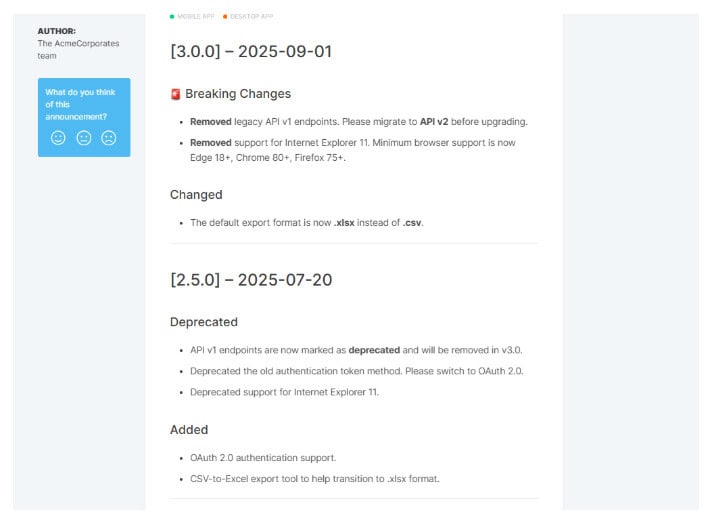
Release Notes:
Release notes should typically be used for external communications or customer-facing audiences and, therefore, should be used differently.
- Release notes use cases are generally focused on informing customers about updates to the product that may be of value to them.
Think of a critical bug fix that may impact a problem that users were experiencing. Urgently providing transparent and easy-to-understand updates about the resolved issue is essential to maintain customer trust. - Another great example would be a new feature or enhancement that impacts external users or customers. Customers should understand the exact value they’ll derive from the new feature, when it will be released, and how to access the feature.
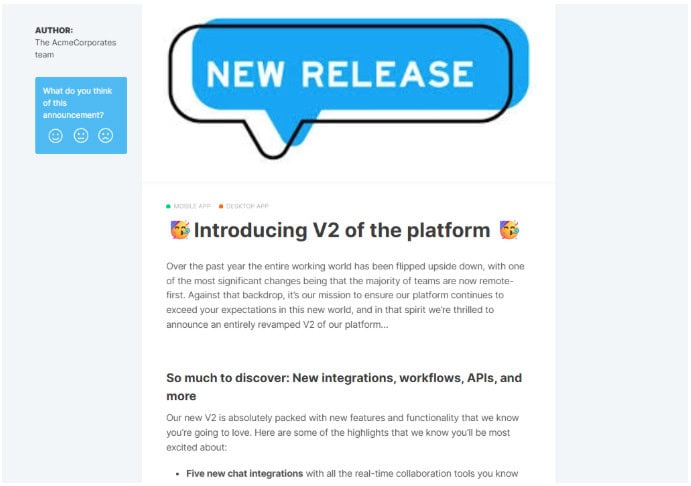
3. Best Practices for Creating a Changelog
There are best practices to follow when creating a changelog based on standards and to help teams maintain consistency across communications. Here are some of the key aspects to keep in mind and how using a tool can help you create the perfect changelogs.
- Changelogs should follow a concise, consistent format:
It’s essential to use the same formatting across all entries and teams. Clear and simplified content layouts help users identify important information easily. Keep it short, concise, and only a couple of sentences long. Your changelogs should be skimmable and easy to read at a glance.
To keep things consistent, I like to create templates that I can reuse later on to ensure I keep things standard, even as time goes on.
Some tools, like LaunchNotes, have pre-created templates that you can tweak and use as a baseline depending on your needs:

- Markdown support and HTML:
I always opt for tools that can help me create changelogs in HTML/markdown first so that I can ensure consistent formatting regardless of where the posts are published, such as email, widgets, or web pages. If you’re unsure of how to do this, tools like LaunchNotes can help you draft these in the correct format with their built-in AI assistant.
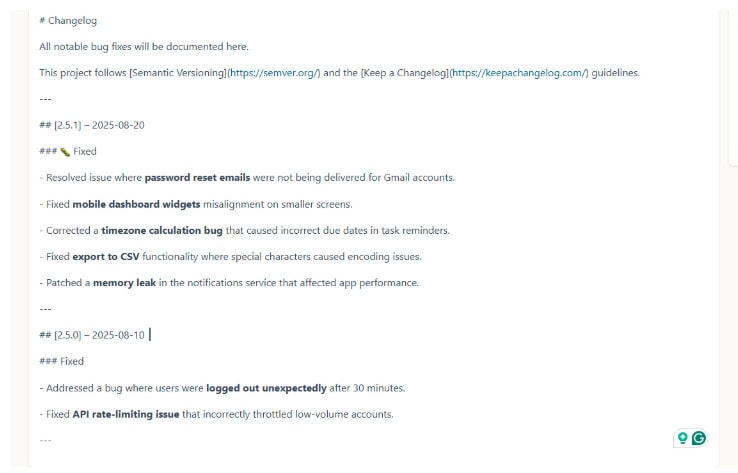
- Changelogs should start with an entry type and version number:
Entries tell users what part of the software is being changed or affected. Here are a few examples below.
Feature deprecation – features that are being shut down or no longer supported.
Fixes – Refer to fixes to the software or bugs that have been resolved.
Added – What features have been added.
Removed – What features or elements have been removed.
Version numbers are critical and help teams and users align on which version is being affected by a change. Here’s a basic sample of a changelog that has precise entry details (what is being changed) and the version that is impacted by this change (clear version numbers). The most recent version changes should show at the top of the changelog for ease of reference.
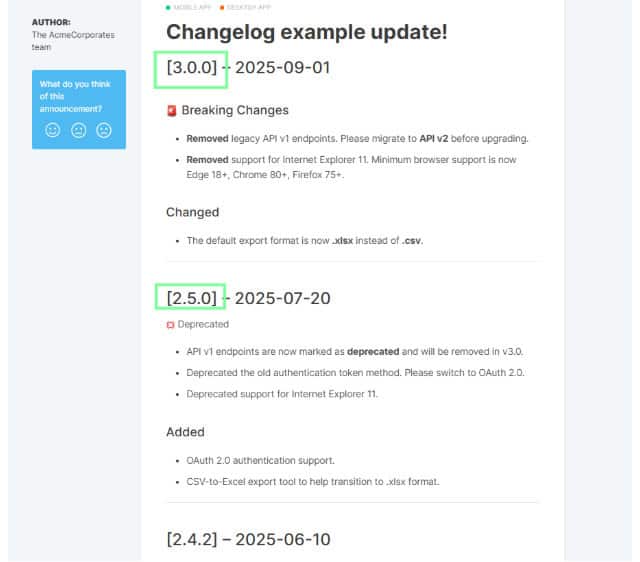
- Changelog date formats and order:
Dates should always be written as YYYY(year)-MM(month)-DD(day)
Standardized date formats (global) will help all users across multiple countries understand the date across all updates.
Your changelog should be in reverse chronological order, starting with the most recent update at the top.
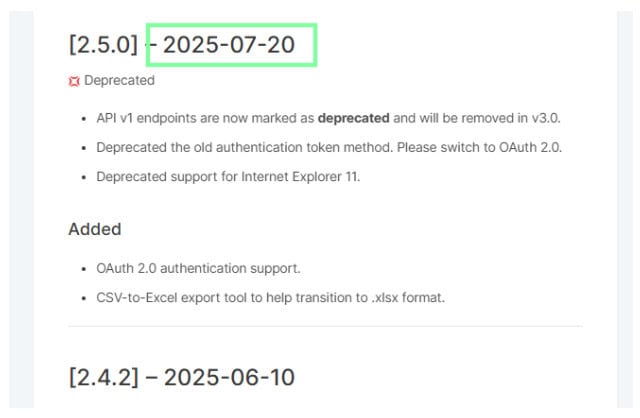
4. Best Practices for Creating Release Notes
Many of the principles that apply to best practices for changelogs also apply to release notes.
Here are some guidelines I would follow when crafting release notes.
- Focus on communicating customer value.
Customer value is the top of the list because it’s critical to consider who you’re speaking to and how to ensure you’re delivering the correct message to your audience.
When creating release notes for customers and external (or non-technical) users, avoid technical jargon and remember that you’re speaking to humans, so ensure your messaging is user-friendly and straightforward. Keep it focused on customer value, explaining how they will benefit from the release or change.
Keep your content smart and eye-catching. Avoid boring text and try to use images, branding, videos, and gifs in your content.
I love this example from LaunchNotes, with an embedded video, users can follow exactly where a new feature is placed within the app and how it works without having to find a guide or figure out how it works.
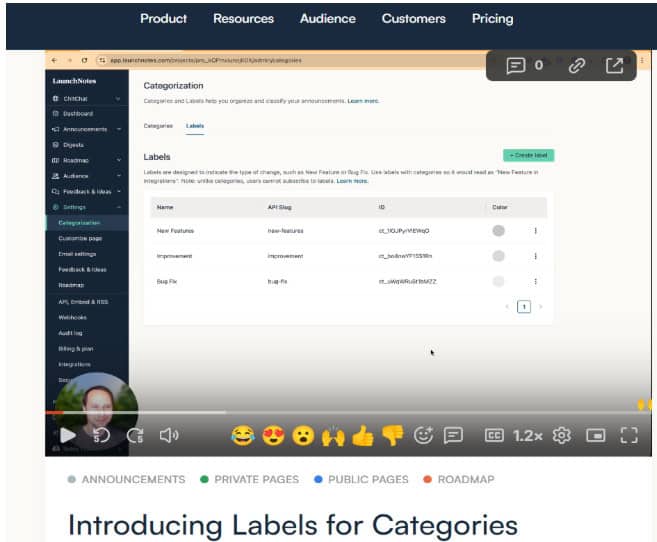
- Target & segment your audience
User segmentation is a really great way to create targeted communications for specific groups or users.
If you have users on a specific plan with unique features, you’ll want to avoid sending out communications to users who are NOT able to access these features. Confusion like this can lead to customer dissatisfaction and confusion.
I like using tools for this reason, as they make segmentation far easier and save a lot of time when needing to split out communications.
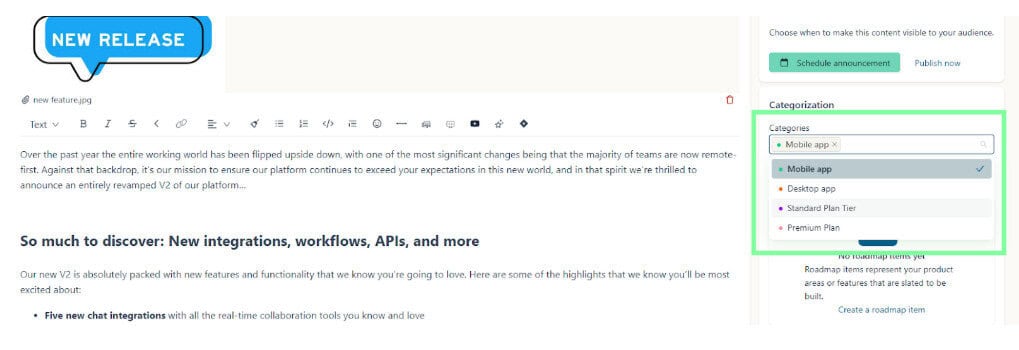
Using segmentation tools, including labels and categories, helps users immediately see what features or parts of the tool will be affected. I love tools that allow customization at this level to ensure you can cater to multiple teams and product features.
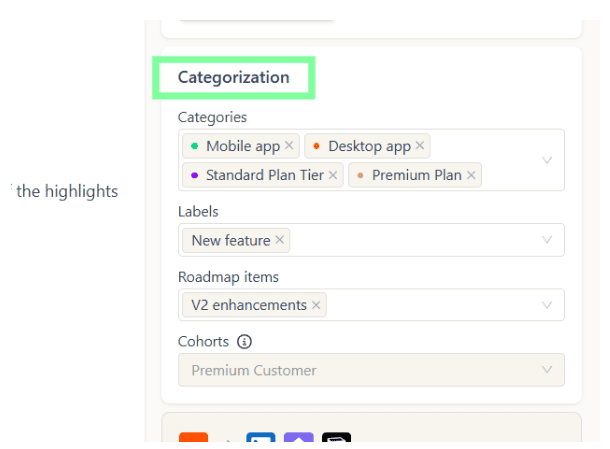
- Publish release notes where users are most likely to see the updates.
Consider where users are viewing details about your product. You may have users who are using your platform daily and are most likely going to benefit from a banner pop-up or an in-app widget.

You may also have users that rarely ever utilise your software but need to receive important updates, and these individuals may benefit best by receiving updates directly via email instead.
Again, I prefer tools that allow multi-channel publishing options and can keep branding, images, and formatting looking professional and eye-catching.
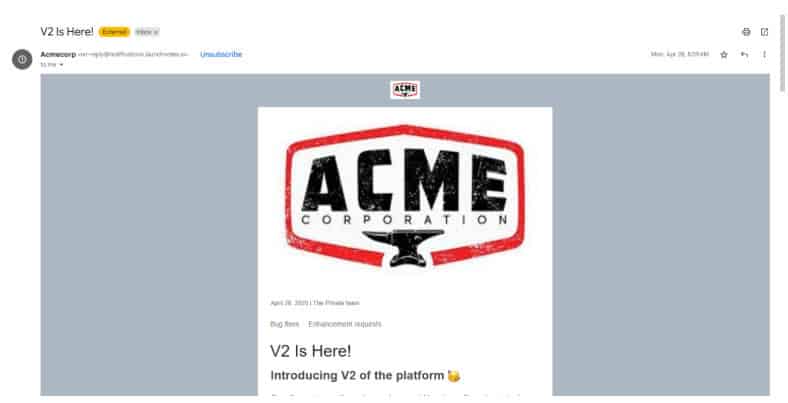
- Guide users on actions and next steps
Users may not know what to expect and if actions are required as a result of a change or update.
Although you’ll want to include some basic guidance, it’s essential to keep your release notes short and concise and avoid lines of long text.
Instead, include useful links to additional resources that may contain full details and user guides. Also, remember to include contact details, should support be required.
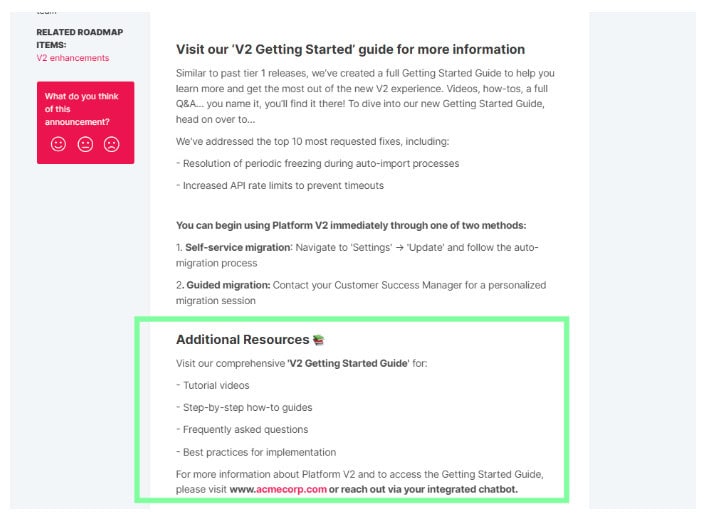
Should I Use Software Tools to Write Changelogs and Release Notes?
While it’s not critical to make use of software to help manage communications, I would highly recommend considering a tool to help automate these processes.
Managing communications manually can be time-consuming, and you run the risk of inconsistent formatting and disparate versions, which can be less accessible if you need to collaborate with various team members.
Gathering user feedback where they are seeing your updates is also a great way to drive customer satisfaction and build trust.
Benefits of using product communication software:
- Save time when creating communications. Many tools allow templated communications, which help maintain consistency and save time.
- User segmentation is far easier to manage with purpose-built software
- Scheduling communications can be automated so that you can publish at convenient times (even across multiple time zones)
- Integrate into your roadmap more easily
- Collaborate with your internal users or product teams in one place
- Collect user feedback and ideas directly from release notes or changelogs – this makes collecting customer or user feedback far easier.
- Analytics and reporting is generated easily so that you can understand your user behavior
Which is Best for Me?
When deciding which is best to use, consider the primary purpose of the communications and who your target audience is.
In some instances, you’ll even want to use a blend of both. You may have a bug fix that contains important technical information in your changelog that your internal teams need to know, but customers may not benefit from the same level of detail.
You can use release notes to communicate customer-facing information that might relate to the bug fix and how this will have a positive impact on users. The release notes can contain images or insights into the fix, but they won’t need to know additional technical details.
In summary, remember that both release notes and changelogs serve the same purpose: to maintain transparency and to build trust. When relevant, use a combination of both, keeping in mind best practices and guidelines for publishing to users.
Also, consider using tools like Launch Notes to manage this and help you save time by automating release notes and changelogs.
LaunchNotes takes the busywork out of product updates. Paste in your notes or tickets and get a structured announcement draft instantly. It’s designed for teams that want to save time, segment updates, and keep communication consistent across every channel.
Related Read


